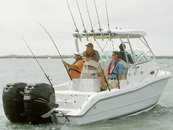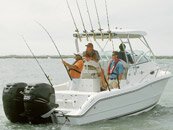Split Tail Sensation
Written by Steve Dougherty
Rig it Right! 6 Steps to Rigging
Step 1
Start by acquiring the freshest bait possible. If you cannot catch your own, frozen individuals will suffice – stay away from packages that appear to have freezer-burn, as these baits will most likely washout after only a short time in the water.
Create a small incision between the eyes of the mullet. Lay the bait on a flat surface and apply pressure directly to the head. This will flatten the mullet’s head and create a streamlined profile, therefore enabling your offering to swim with a more natural appeal.
Step 2
Run your knife along the backbone in the direction of the tail. Start behind the dorsal fin and when you get to the tail, slightly angle the blade – the tail should easily split in half. Once you have properly split the tail, remove the backbone and most of the meat attached to the skin of the mullet.
Step 3
Measure your hook(s) against the mullet’s body to approximate the proper placement. Choose a hook size that is proportionate to the bait you are rigging. If you use a hook that is too small, you run the risk of having your hook(s) double back on the bait.
Step 4
Working from the tail to the head, insert your hook(s) and make sure the hook-eye is aligned with the incision you made between the mullet’s eyes.
Step 5
Take your preferred leader-of-choice (preferably wire to avoid cut-offs from toothy predators) and thread it through the incision you created in the mullet’s head. Now you can pass your leader through the hook-eye and egg sinker. Make a haywire twist, but be sure not to over-tighten as the bait may bind and spin while trolled.
Step 6
With large mullet, tie a piece of wax thread around the head and gills or use a plastic wire tie to create a low-profile shape and protect the bait from washing out.
Like every facet of sportfishing, there may be some tweaking required for your bait to swim perfectly. Knowing how to make these slight adjustments will only come with years of experience. Remember…practice makes perfect.
Shared with Permission by FloridaSportFishing.


